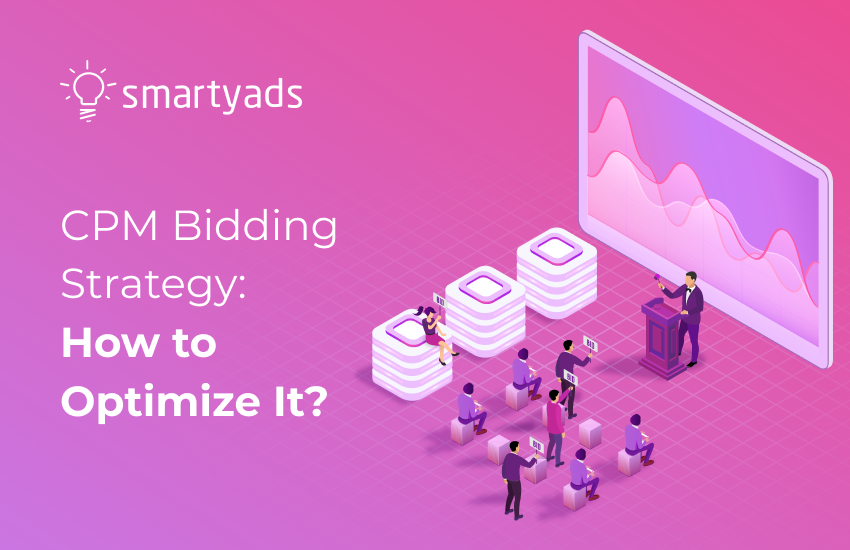Programmatic advertising is evolving every day and it already has many different options and strategies.
There are different pricing models for programmatic advertising campaigns. Each of them has its advantages and disadvantages depending on what goals you want to achieve with advertising.
Some bidding strategies allow you to maximize conversions, some are needed to increase awareness or focused on the number of clicks.
Bidding strategies can be varied and at first, they may surprise and confuse a person who is not familiar with them at all. However, they are all useful in their own way.
In particular, a very interesting and versatile bidding strategy is CPM bidding, because it can be used in different situations and with different purposes. We will tell you about this further on.
What is CPM bidding strategy
Price per thousand impressions (CPM) is a marketing term used to refer to the price of 1,000 ad impressions per web page. The "M" in CPM stands for "Mille", derived from the Latin word for "1000".
Programmatic advertising is conducted in an auction environment, also called automated bidding. The Supply-Side Platform SSP sends requests to Demand-Side Platforms DSPs, and if campaign criteria are met, DSP takes part in the real-time bidding auction and bids for impression, the highest bid wins in the competition.
The price per thousand impressions is your base and maximum bid in the ad auction. CPM, or cost per thousand impressions, is the price you pay for every 1000 impressions.
The higher the starting price per 1,000 impressions, the higher the chance that your ad will be shown. If you raise the threshold for bid parameters, your chances of winning in RTB auctions will greatly increase.
The best part is that the ad exchange will only charge you when you need to place your ad above the next highest ad.
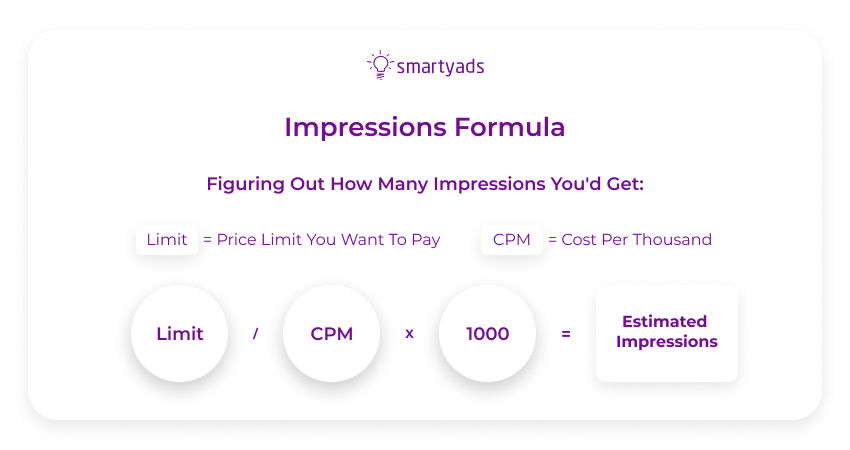
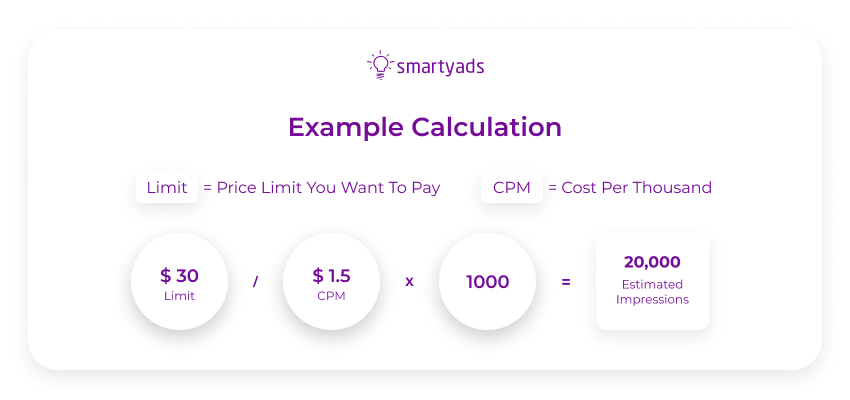
The cost per thousand impressions has two main defining criteria:
1) Price per thousand data impressions or the cost of using audience data to find targeted leads or similar audiences;
2) Media CPM or price per thousand impressions for display ads when your winning bid matches the parameters of your campaign, ad group, and creative.
In addition, the terms and conditions for showing ads on a given platform may depend on criteria such as:
- Ad relevancy score;
- Ad frequency;
- Audience size;
- Audience location;
- Seasonality;
- Placement;
- Ad creative (whether it's an image or video ad).
It is extremely important to distinguish the price per thousand impressions from other common advertising metrics with similar acronyms, such as cost per conversion or cost per click.
CPA bidding stands for Cost per Acquisition (also known as target CPA) and indicates how much money you need to spend per conversion. But the price per conversion in target CPA is average, so you can spend more than you wanted. Target CPA is still a great tool for setting up ad campaigns.
CPC bidding stands for "cost per click" and means the amount you pay for each click on your ad. Tracking all of these metrics together is useful if you want to get accurate information about the effectiveness of your advertising campaign.
Why is CPM bidding strategy important?
Cost per thousand impressions is an appropriate metric for different types of marketing campaigns because your primary goal of a campaign is not always to maximize conversions.
Sometimes, you need to create multiple campaigns with a high number of impressions in order to reach as many new target audiences as possible and increase your brand awareness.
In this case, measuring and optimizing the campaign by impressions will be much more valuable than optimizing the ad spend by clicks.
For example, new brands that have just entered the market and need to increase their name or brand awareness, with new products or services may be more likely to seek broad outreach than direct sales or subscriptions.
At the same time, focusing on CPM will allow you to determine the most effective marketing channel for future advertising campaigns, as you may find that your price per thousand impressions on a programmatic platform is lower than, for example, your price per thousand impressions on Google Ads.
What is it?
It's a feature that automates your bidding so that it stays in the optimal price range while still being competitive. It is part of automated bid strategies.
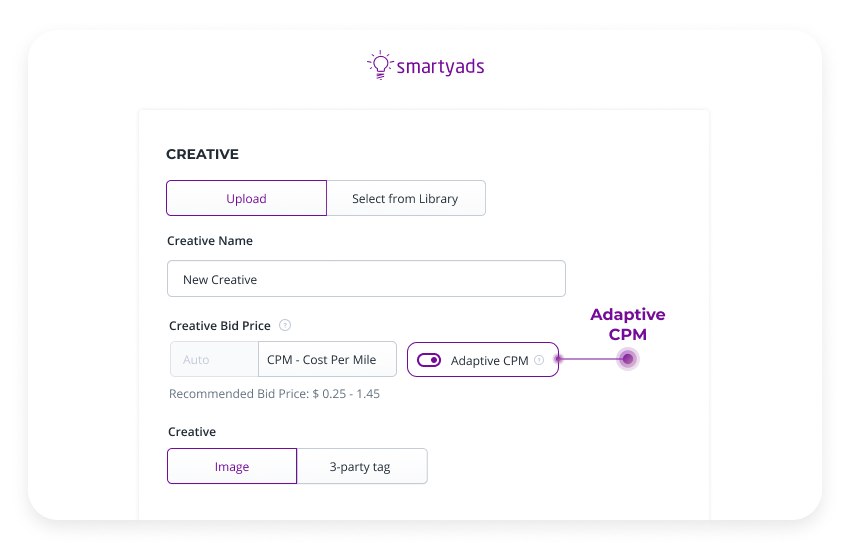
Why is it useful?
This feature will be very useful for marketers with limited budgets, as it allows them to stay within the set price and still get the displays they want. Adaptive CPM will choose impressions within the threshold you set a maximum cost per thousand impressions. Yet, it will continuously analyze the traffic from sources to offer the most competitive price that wins in the auction. This way advertisers do not overpay but still win the best impressions.
What is the difference between manual bidding, smart bidding, and automatic bidding strategies?
To understand the advantages and disadvantages of a particular bid strategy, you need to know how they work at least in general terms. So here we will look at other bidding strategies that exist and how they can be used.
Bidding strategies can be different in the way they work. We will now discuss these differences as well as their pros and cons.
Manual bidding
Manual bidding is exactly what it means; you adjust your bids manually at the keyword or at the ad group level. So, you tell the platform on which you run your ads the maximum amount you're willing to bid in an auction for your keywords.
You can set a total bid at the ad group level for all keywords in that ad group, or you can itemize your bids by keyword.
We recommend getting itemized if you are going to bid manually. This will allow you to see a more believable picture of what's going on in the auction and help you understand how to proceed.
Pros of manual bidding strategies:
- Great control over ad spend;
- Greater control of your campaign;
- Have a detailed understanding of the settings.
Cons of manual bidding strategies:
- Spends a lot of time;
- Less detailed analysis of results;
- Campaign effectiveness depends only on the competence of the marketer.
Automated bidding
Automated bidding strategies are strategies that use machine learning to optimize your bids on your behalf based on specific campaign goals that you have set.
How the platform will optimize your bids depends on the strategy you choose and the goal this strategy is pursuing.
For example, if your main goal is conversions, then the platform will optimize your bids to maximize conversions, if it's impressions, then the platform will adjust your bids accordingly so that you get the right number of impressions, etc.
Pros of automated bidding strategies:
- High rate of achieving campaign goals;
- Detailed analytics of the campaign data;
- Saves time on campaign settings.
Cons of automated bidding strategies:
- Since the settings usually put the average price per conversion or view, you may exceed your budget.
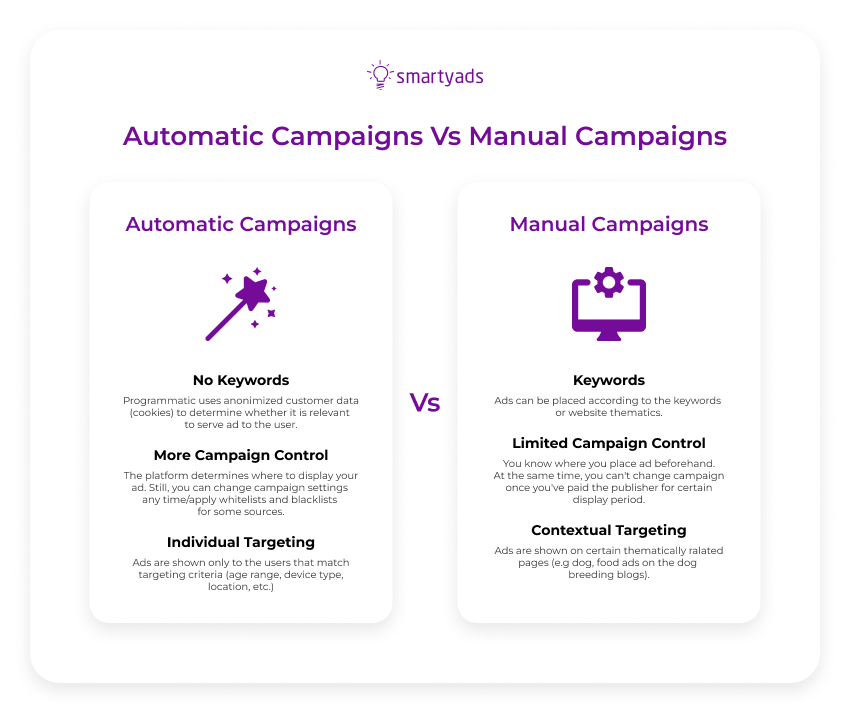
Smart Bidding
Smart bidding is part of automatic bidding that use machine learning to optimize conversions or the conversion values in each auction time bidding. This feature is also known as "bidding during the auction".
Smart bidding includes target price per conversion, target return on advertising investment, the maximum number of conversions, maximum conversion value, and Enhanced Price Per Click (ECPC).
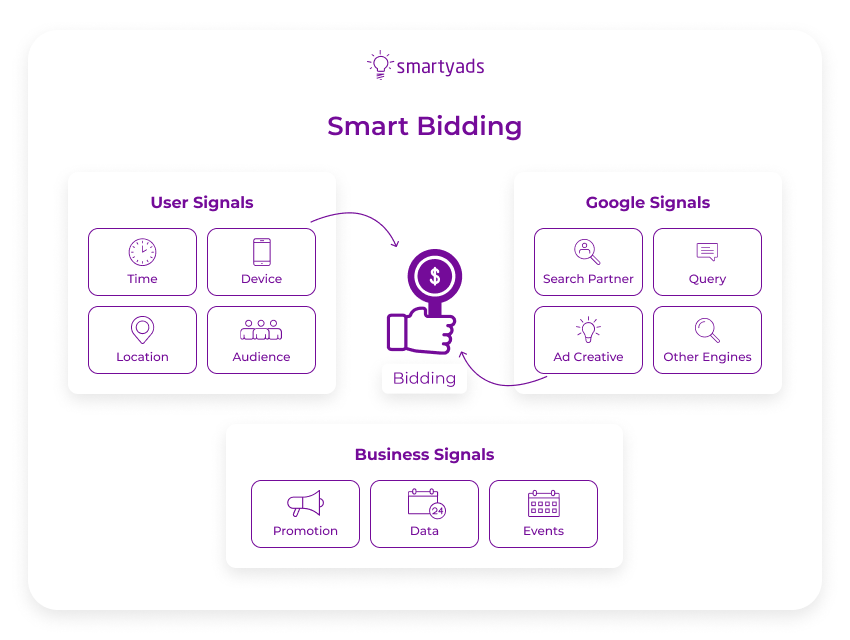
Such bid strategies are the next level of automatic bidding and they will most likely become the main tool for launching ad campaigns for most marketers after a while. By the way, SmartyAds' Adaptive CPM is also part of the smart bidding strategy.
The pros of smart bidding strategies:
- High rate of campaign profitability;
- High rate of achievement of campaign's objectives;
- Detailed analytics on campaign data;
- Saves time on campaign settings.
Cons of smart bidding strategies:
- Since the settings usually put the average price per conversion or view, you may exceed your entire budget.
However, different online advertising platforms may have different bid strategies, settings, features, and pricing rules. That's what we'll talk about next.
What are bidding strategies on Facebook?
At first glance, Facebook's advertising system seems very confusing and complicated, but it's not that hard to figure out. For example, there is an official guide from the developers to help those who are new to Facebook advertising.
If you don't want to spend a lot of time checking out the guide, we'll give you a quick rundown on how payout models work on Facebook.
1. Lowest Cost (Automated Bidding)
This is a fully automated bidding system for showing ads. The system itself chooses the rate at which the display will be carried out. In other words, you run an ad and can forget about it until the campaign is over.
This format is suitable for brand awareness campaigns, and if you can and are willing to spend the entire advertising budget automatically.
2. Bid Cap
This type of campaign is similar to the first, but it gives you more room for manual bidding. You can set bids and control bid prices yourself. This strategy spends less money on ads but requires more time to monitor the campaign.
3. Cost Cap
It is an automated bidding strategy. This option will suit you if your campaign's key goals are traffic on the site, reactions to the event, or conversions.
In this pricing model, the bids are automatic, however, you may set up in your personal ad cabinet what maximal price you are ready to pay for the advertisement.
4. Target Cost
The bid strategy is right for you if the goal of your campaign is conversions or lead generation. It allows you to set a target cost per ad impression, but in this case, Facebook may underpay or overpay for the impression.
It is also a type of automated bidding. This format is great for gathering analytics and market research.
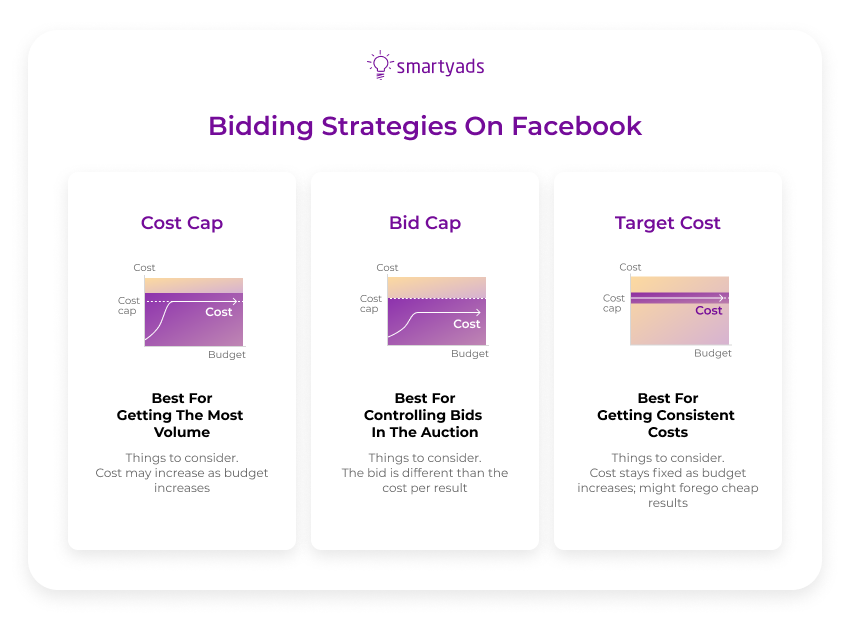
5. Maximize conversion Value with Minimum Return on Ad Spend (ROAS)
With this strategy, Facebook sets a specific rate to maximize conversion value. If you use ROAS (which can be a portfolio bidding strategy as well) as your primary measure of success, this is a good option.
This bid strategy will focus the campaign on pure profit, so you get the most bang for your buck while keeping your ROAS to a minimum.
6. Highest Value
With this bidding strategy, Facebook chooses bids that bring the highest value to your brand. Facebook will choose the most profitable display depending on what your campaign's primary goal is: app installs, conversions, or catalog sales.
This bid strategy is right for you if you want to increase the profitability of your advertising campaigns.
What are Google Ads bidding strategies?
Google Ads bidding strategies are numerous. We will consider the most interesting of them. So, the most interesting and important Google Ads bidding strategies:
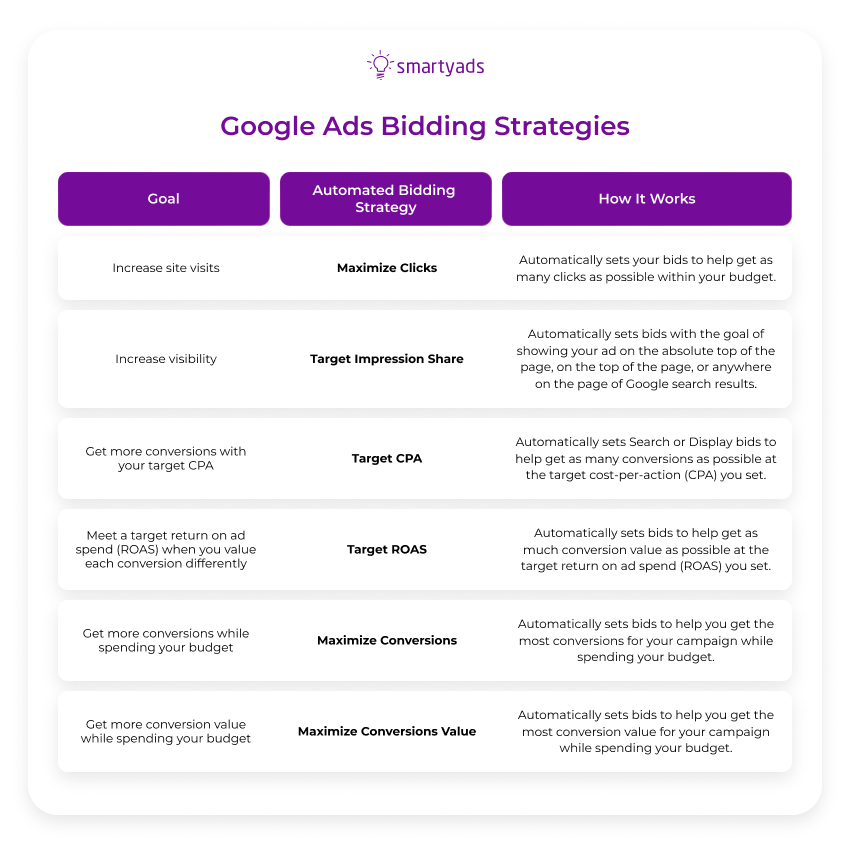
1. Manual CPC bidding (cost per click)
This Google Ads bidding strategy is right for you if you want more control over costs and expenses; it allows you to manage your maximum CPC bids.
With Manual CPC bidding, you choose the price you are willing to pay for each click. Once you set these settings, Google Ads platform ensures that you never spend more than this amount per click. Your maximum CPC bids will be controlled by these settings.
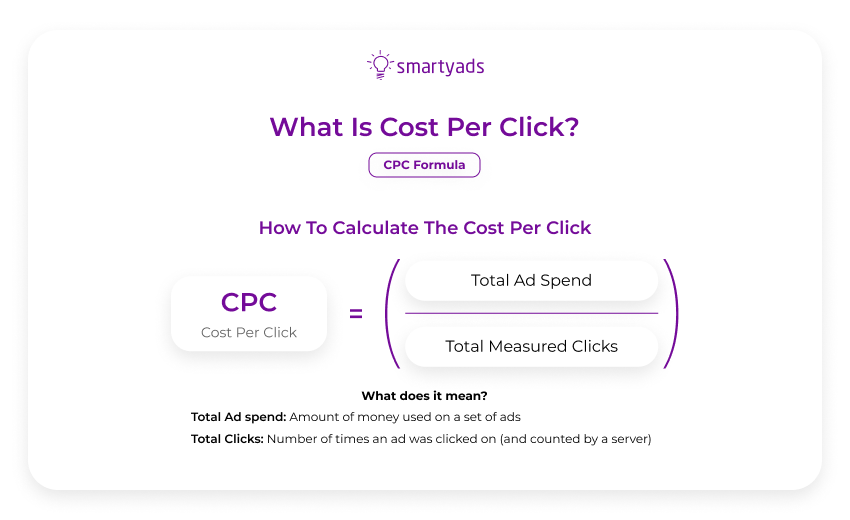
But remember that when you use manual CPC bidding, you will receive less detailed reports than with automated bids.
In addition, manual CPC bidding does not involve using Google's machine learning algorithm to find users who are more likely to make a conversion than others.
2. Target CPA
Target CPA allows you to set a maximum price per conversion or other targeted action which you can also choose in your settings.
Target CPA is also a type of portfolio bid strategy (the other strategy that applies across multiple campaigns, rather than applying different strategies at the level of each campaign).
According to Google Ads, "By using historical information about your campaign and evaluating contextual signals present during the auction, Target CPA automatically finds the optimal rate for your ads each time they are eligible to be shown. Google Ads sets these bids to achieve an average price per conversion".
With target CPA, you pay for conversions, not clicks. However, you will be unable to set a maximum CPC rate when using a target CPA automated bidding strategy for individual campaigns.
3. Target ROAS (Return On Ad Spend)
You can determine how much you want to get out of your ad spending with PPC advertising.
This Google Ads bidding strategy will work for you if you want to maximize conversion value by setting a target ROAS for your advertising investment.
But using this strategy requires you to provide Google Ads with product revenue information to find out which keywords are most profitable and will be optimized for the terms that will return the best ROAS. With it, you can also create a portfolio bidding strategy.
4. Maximum number of clicks
Sometimes when setting up contextual advertising all the marketer cares about is a large number of clicks.
The Google Ads bidding strategy of maximum clicks is an automated bid strategy. Google Ads itself will set up the campaign so that you get the maximum number of clicks.
The main thing you need for this strategy is to set the average daily campaign budget, and then Google Ads campaign will do the whole thing for you.
But when you use this bidding strategy, the clicks and conversions may be of poor quality. Don't forget to keep this in mind as you choose this strategy.
5. Maximize conversions
If conversions are the main indicator of the success of your advertising campaign, then the maximize conversions bidding strategy will suit you even better.
In that case, the Google Ads system will focus on optimizing your strategy to maximize conversions.
The Google Ads bidding strategy is automated, so it will suit you if you're willing to spend your entire budget. But it also is very good at gathering conversions.
In this case, Google Ads is interested in getting as many conversions as possible, but it may increase your costs and increase your price per conversion.
There's also the possibility that the return on your advertising investment will go down.
6. Target Search Page Location
This Google Ads bidding strategy will work for you if you know what location you want to get on the search engine page.
Google Ads will optimize your bidding strategy so that your ad shows up in the location of your choice.
7. Target winning percentage
In this case, Google Ads campaign will allow you to choose how often you want to be above your competitors. However, because of this, the price of displaying your ads may increase.
This Google Ads bidding strategy will work for you if your main goal is to get ahead of your competitors and increase the authority of your brand in the market.
8. Price-per-conversion optimizer
This is a half-automated Google Ads bidding strategy. It allows you to automatically adjust manual bids to maximize conversions.
This bidding strategy will work well if you are testing pay-per-click ads, as it is essentially just an extended version of the manual cost-per-click strategy.
9. Target CPM (cost per 1,000 impressions)
Previously, this bid strategy was available for Google Ads display campaigns, but now it can only be used for YouTube campaigns.
In this Google Ads bidding strategy, you set the price per 1000 impressions, which is not the maximum but the average price. The impression is counted regardless of whether the user viewed your ad or skipped it.
Potentially, such a system can cause significant losses in the advertising budget, but your ads will be displayed to as many unique users as possible.
There is also the option of CPV bidding, which means cost per view. With CPV bidding you can pay only for video ads views or interactions. But CPV bidding is more expensive.
Which bidding strategy should I choose?
Facebook and Google Ads are probably two of the biggest platforms for media advertising, so there are a lot of different bid strategies and it can be difficult to choose the right one. Besides them, there are also programmatic platforms that also have their own nuances in the bidding process.
Facebook, Google Ads, and programmatic platforms use machine learning and artificial intelligence to quickly analyze and adjust bids in the bidding process in real time.
All of these processes happen automatically in a split second, making the ad bidding process increasingly automated.
However, in order to make your ad campaign work as it should and achieve its goals, you'll still need to choose which cost and ad display model you want to bid on.
We'll look at three simple steps with which you can work and choose any of the bidding systems we described earlier.
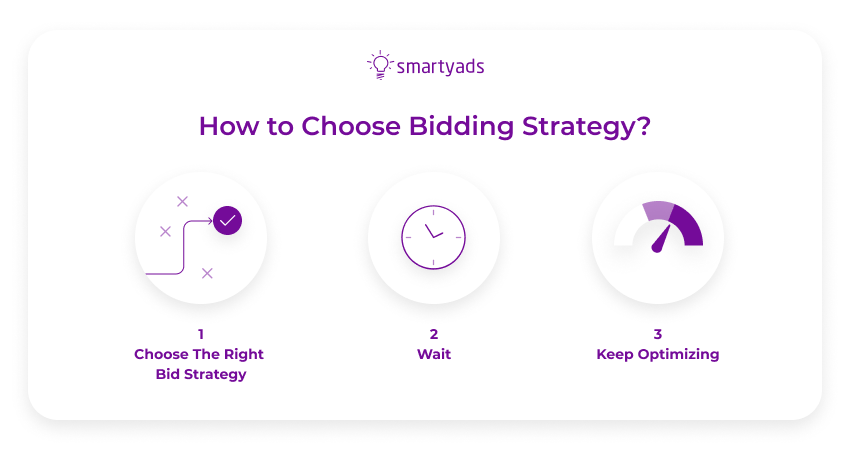
1. Choose the strategy you want to work with
Before you choose a bidding strategy, you should understand the goal of your advertising campaign. Do you want to increase the number of conversions? Do you want to get a certain number of clicks? Do you want your brand to become better known?
There are acceptable bidding models for all of these requests. The safest option is probably CPM models because they can achieve several goals at once and are not very resource-consuming for your advertising budget.
But let's look at the practical use of other strategies. For example, Skechers was facing increasing competition in the shoe market in Spain. They vitally needed to increase sales and brand awareness. So they used the Target Price for Conversion strategy with Google Ads.
It allowed marketers to determine at what conversion value, conversions would be maximum. Skechers claims that with a campaign based on this strategy, their conversion rate increased by 214%.
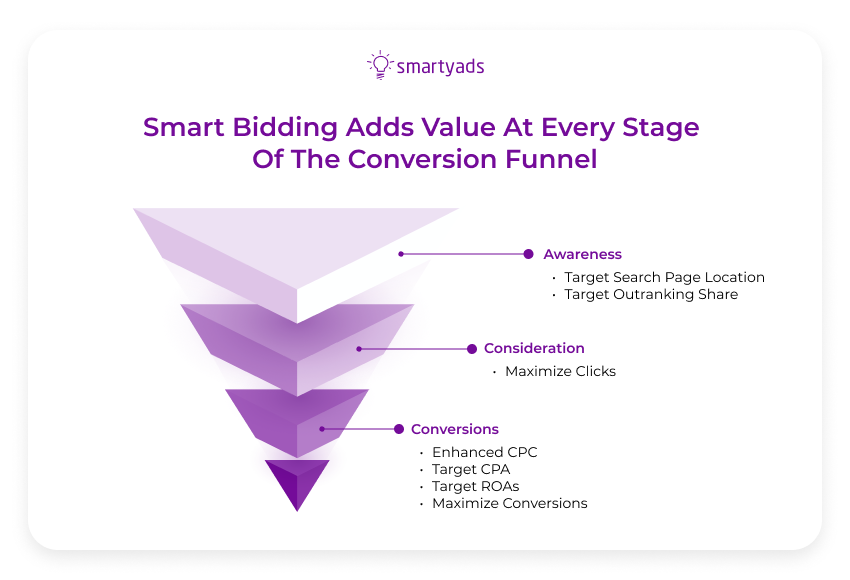
Now let's break down the use of a targeted ROAS (Return On Ad Spend) strategy. It can be set up if you already have a campaign bringing in a certain number of conversions because otherwise you simply won't have data to fall back on.
Happy Socks, a Swedish clothing company, began expanding into new international markets. To do so, they needed to maximize conversion value without increasing their ad spend.
In this case, the targeted ROAS works just fine. At the end of the campaign, Happy Socks reported a 30% increase in ROAS in more than 20 markets, a 20% reduction in costs, and a 10% increase in sales.
2. Wait
When we try to learn something, we need time to memorize and process the material in our heads. With machine learning, it's exactly the same. It takes time for the system to make all the algorithms work as they should. Usually, it takes about a week.
Keep in mind that a week is the average amount of time. Machine learning time can vary, it depends on how much conversion data is available, conversion delays data, and how much time passes between a click and a conversion.
Usually, in the bid assignment strategy report, there's information about how much time is left before the end of the learning period. So be sure to check it out and don't make many changes to your campaign during the learning period.
After the learning period is over, leave your campaign for a few more weeks. After that, determine the average time it takes for a click to result in a conversion. The resulting number will be the answer to the question "how long do I need to wait to run the analysis?".
For example, your average latency is 4 days. 1 week is the training period, then another week or two for the launch of the campaign itself. And another 4 days after that, you can launch the campaign performance analysis for the first 2 weeks of the campaign.
3. Keep optimizing
Automated bidding strategies free you from extra work and save a lot of time. However, in order for them to remain effective, you should not forget about them at all after launching your multiple campaigns.
Don't forget to analyze the effectiveness of your campaigns, try to correct them, and do A/B testing (but don't forget to follow the first two steps as well).
Your campaign will be successful if you know your goals and try to achieve them. Don't be afraid to make mistakes, as they also lead to success, and take advantage of the benefits that programmatic advertising gives you. Machine learning can and will work for you.
To sum it up
Choosing a bidding strategy is always a very important task and it should be approached responsibly. In this article, we have tried to tell you how to do it in general terms, what are the main bidding strategies of different platforms for launching media advertising and what are their main advantages.
There is no one right strategy for everyone. Each strategy is unique and tailored to a specific goal set for a specific period. Any of the strategies we've talked about above will work for you, as long as they fit your goals. However, in order for it to work the way you want it to, you will have to learn more about it.
If you don't have an expert who knows how to set up advertising campaigns, it's better to turn to programmatic platforms, because setting up ads there is very intuitive and automated. In addition, such platforms always have a customer support department, which is always ready to help and explain everything you do not understand.
Why CPM?
We have emphasized this strategy because it is the most flexible and profitable one. Especially if you're just starting out in programmatic or contextual media advertising and you need some time to analyze the market and for your brand to become more recognizable to users.
